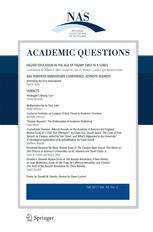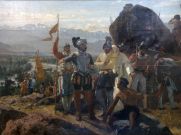The Envy of Excellence: Administrative Mobbing of High-Achieving Professors by Kenneth Westhues. Lewiston, NY: Edwin Mellen Press, 2005; 355 pp., $139.95 hardcover
The Envy of Excellence is an odd but absorbing case study of “mobbing” in the workplace. Mobbing is defined as a “‘common and bloodless form of workplace mayhem’ usually carried out politely and without violence.” It is one of the ways “the eliminative impulse manifests itself in the workplace” (p. 40). In short, it is what members of a formal organization do to rid their organization of someone who has fallen out of favor—masking their irrational passions with bureaucratic rituals designed to overwhelm the individual target. These rituals purport to be rooted in rational norms and transparent procedures. They are anything but.
According to the author, the desires “for food, for sex, and for humiliating somebody else” (p. 27) are fundamental to the human condition. They drive people in often obsessive ways. The mobbing instinct stems from the desire to humiliate—and eventually eliminate—an opponent. But because the eliminative impulse is contrary to the higher aspirations of humanity, it must be cloaked. The formalism of bureaucratic quasi-judicial proceedings is the perfect cloaking device for the modern age. Contrary to the Weberian model of bureaucratic rationality, bureaucrats are perfectly capable of acting with the passion and hatred of a mob, albeit they act at a glacial pace. “Workplace mobbing is the collective expression of the eliminative impulse in formal organizations” (p. 42). By elimination, Westhues points to the observable sociological fact of people being systematically “separated utterly and completely from the social organism” of which they were once an integral part. There is a didactic component to such elimination, hence the necessity for bureaucratic procedures and their outcomes becoming causes célèbres.
The book presents the story of Herbert Richardson, who was a prominent, tenured professor of religious studies at St. Michael’s College of the University of Toronto until he was “mobbed” and finally “eliminated” from that corporate body in 1994. The “mobbing” occurred in phases, commencing in 1987 with a formal request for his resignation, followed by various forms of “marginalization, isolation, harassment, inching out” (p. 197), and lasting until his eventual dismissal. The book therefore concentrates on the academic workplace, though the phenomenon is common to other working environments. It is a book about “exclusionary processes in organizations” as well as “the current state of academic life” (p. 13). The style is uneven, yet ultimately gripping. Two aspects of the book—fully disclosed in the first chapter—might encourage critics to dismiss it on the grounds of special pleading: its author was himself the subject of an academic mobbing at his own institution, and the publisher of the book—Edwin Mellen Press—was founded by the very man, Herbert Richardson, who is the subject of the book. Dismissing the book on such grounds would be a mistake, however. Westhues is a sociologist and leading expert on the phenomenon of mobbing whose work long predates his acquaintance with either Mellen Press or Richardson (p. 99).
Richardson’s case was the subject of media attention across North America, including in Canada’s leading national newspaper, The Globe and Mail, and the now defunct academic journal Lingua Franca. Much of this coverage was grossly distorted, according to the author. The mobbing crowd tends to merge an allegation of wrongdoing—however obscure or trivial—with the very identity of the person whose integrity, and suitability as a member of the community, is being impugned.
In times and within institutions where physical violence has become unthinkable, one must look for clues that an eliminative mobbing is occurring. Indicators include such things as a popular, high-achieving target, lack of due process, odd timing of eliminative actions (designed to maximize the advantage of the accusers), resistance to external review, secrecy of proceedings, vague charges, unanimity of enlightened opinion, prior marginalization of the target, etc. As in Philip Roth’s academic and psychological novel The Human Stain, the target of a mobbing is usually an overachiever who is capable of standing outside groups and group impulses. As an outsider looking in, he appears, like Socrates, suspect to the mob. Not only the means, but the permissible reasons or bases for mobbing have adapted to modern conditions. All societies have sacred cows. Professors are not usually mobbed and eliminated simply for what they say, in isolation from who they are. “Like sex, race, religion, and sexual orientation, academic speech and writing are forbidden grounds of social elimination.” The mobocratic spirit, as Lincoln called it in his Lyceum Address, must nowadays act more subtly, against more elusive targets—but find its targets it will.
Richardson is presented in the book as a man who stood against the tenor of his time and place in a variety of ways. He was a devotee of Enlightenment reason in the postmodern university, a man concerned that ideas and arguments would increasingly be explained away “as mere artifacts of social position” (p. 80); he was a liberal, ecumenical Protestant on a Catholic faculty; he was a man “at odds with both the secular mainstream and the Church of Rome”; he was a man of entrepreneurial drives in a stultifying academic environment that looks down on such things; he was an associate of other individuals and movements unfashionable in the eyes of elite opinion shapers; he was an inner-directed man of many gifts, but none of them was for academic governance; he was an “artist” in a world of “technocrats.” His various positions or multifaceted identity might, depending on the observer, be categorized as “conservative” or “liberal,” or both. But it is clear that he stood out, and threatened regnant orthodoxies. In short, he presented a clear target. More generally, Westhues suggests that to calculate the odds of being mobbed, “count the ways you show your workmates up: fame, publications, teaching scores, connections, eloquence, wit, writing skills...looks, clothes, spouse, children, sex appeal” (p. 163).
One weak part of the book is the insinuation—for this is all that it is—that there is a link between then Cardinal Ratzinger’s concern for the Catholic tradition and the spirit of the mob. But the evidence adduced, such that it is (including—heavens!—“a much-publicized lecture on doctrinal orthodoxy” that Ratzinger gave at St. Michael’s in 1986) does nothing to establish a direct or even indirect link between them. It is indeed very hard to imagine tension among major Christian denominations fueling anything in the University of Toronto of the 1990s. In fact, when this evidence is presented, the work takes on a tone of anti-Catholic animus, and even sensationalism, that is unseemly in a scholarly study. The fact that the book was recently re-issued in a “trade” edition as The Pope Versus The Professor: Benedict XVI and the Legitimation of Mobbing does nothing to quell these concerns. Ratzinger is mentioned on only a handful of pages of a very long book, and the re-titling appears to be nothing more than a shameless attempt to cash in on his recent elevation to Pope. Another flaw in the book is the author’s failure to present fully the other side of the questions he raises. Documents and historical timelines are examined, sometimes in a cursory fashion, but nowhere does the author interview or really try to understand Richardson’s bureaucratic inquisitors as they understood themselves. They are portrayed as making mountains out of molehills, of twisting violations of relatively undefined policies or expectations into grounds for dismissal, but it is impossible from the book to get a full sense of their motivations or even the exact procedures and constraints under which they operated. The book would profit by devoting some space, in the first chapter, to laying out the exact allegations that were made against Richardson, what prima facie evidence, if any, supported such allegations, and the details of the University’s administrative procedures in dealing with such allegations. (Some, but not enough, additional details of the Richardson case are filled in by ten “Essays in Response” which form appendices to the book).
Nonetheless, Westhues succeeds in identifying an enormous range of attitudes, behaviors, institutions, and character types that anyone familiar with today’s university will immediately recognize. The more the book abstracts from the particulars of Richardson’s case, the more compelling its argument becomes. For example, for a bureaucratic mob to do its work, there must be a bureaucracy, and Westhues correctly identifies a new class within the modern university, increasingly divorced from the professoriate: “career managers adept at smiling and sloganeering...but bereft of academic leadership and direction” (p. 83). Like all bureaucrats, they are jealous of their power, a hallmark accentuated by the fact that the postmodern relativist university offers nothing other than power to hold on to, as all moral certitudes—including even confident liberal purposes—are systematically debunked. Members of this new class handle complaints against individuals—as do all human beings—partly on the basis of whether the person that is the target of the complaint is in their good books or their bad books (p. 210). Managing an environment lacking authoritative standards, they also tend to side with majority opinion (a tendency of our democratic age pointed to in both The Federalist and Democracy in America). They then resort to pretexts to mask their preconceptions.
The book doesn’t establish Richardson’s “innocence” of the charges leveled against him, nor is it intended to. At its heart, the book is a searing critique of the rituals of managerial power. In the end, Westhues advocates education, not legislation or quasi-judicial bodies, to fight workplace mobbing, for the latter will only result in the “establishment of additional institutional mechanisms for the wielding of managerial power” (p. 305). Those who march to the beat of their own drummers (as Richardson did, by Westhues’ own account) are a lesser threat to the integrity of the university and other bureaucratically managed organizations—not to mention the integrity of human relationships—than the pretextual use of this managerial power.
Academic Animals: A Bestiary of Higher-Education Teaching and How It Got That Way by Lois Roney. Xlibris, 2002, 277 pp., $31.99 hardcover
In contrast to Westhues’ dark and disturbing book, Academic Animals is a light and breezy romp through the wilds of academe. But like The Envy of Excellence, it presents character types that are immediately recognizable. In fact, borrowing a technique from Theophrastus and Chaucer, Lois Roney’s entire effort is dedicated to offering a series of “character sketches.” The sketches are of academic animals in their native habitat, especially as they teach, or contemplate the teaching of, undergraduates.
Each of the book’s 18 chapters presents one academic archetype, symbolized by a particular beast. The Rooster is an “academic visionary” who is in the thrall of a new interdisciplinary theory of learning and is attempting to impose it college-wide. “‘I am the model for everyone,’ he crows, stretching up his pointy beak and arching his copper-colored wings to the sun. ‘Look at me....Learn from me. I will vitalize your thinking. Tradition is evil. I am the good. Follow me.’ Not for him the syllabus. Not for him the organized lecture or focused discussion or wide-ranging reading list. He doesn’t hold class; he holds court” (p. 17–18).
Meanwhile, the Armadillo, a faculty member in professional regress, has discovered “the key to professional survival is shared personal taste” (p. 38) and the Mule, an academic enabler specializing in remedial education, has slowly and stubbornly worked her way to tenure “not by the quantity of her research nor the quality of her teaching, but by constant braying about the need for ever more remedial courses and ever more staff to teach them” (p. 44).
For Boar, the faculty bully, “nothing is too insignificant to rouse him to a searing two-page memo or a bristling encounter in the hallway” (p. 53) and what he most enjoys about the academy “is not the research or the teaching, but the meetings—department meetings, department committee meetings, college meetings, college committee meetings, faculty Senate meetings, Senate committee meetings....For these the adrenaline flows, the shoulders hump....Boar has served at least once on every committee on campus....” (p. 54). Boar might well come to blows with Rhino, the obdurate traditionalist, for whom “life in the academic grassland is no longer fun” due to “unnecessary, idiotic, federal and university regulations” that require him “to account for everything he says or does” (p. 77–78). But it is less likely that Boar will butt heads with Bullfrog, the historian who has “puffed himself up to be the biggest creature in his small corner of the academic pond” (p. 109). His teaching load is so light, and salary so high, that he is on campus too rarely to be threatened by the Darwinian struggle that puts others on the verge of extinction through exhaustion. Bullfrog is far too busy getting his Ph.D. students tenure-track jobs in cutting-edge, made-up subfields to be concerned with normal academic politicking.
Llama, the disaffected faculty member, has rather the opposite tendency of Bullfrog. He was once talented and energetic, but due to the changing administrative priorities of his small private college—reflecting and shaping its desire to be “market-driven” and “customer sensitive” (p. 183)—he is, by choice and adaptation, becoming “deadwood.” His English department increasingly offers service courses for students in vocational disciplines. Seeing no benefit to anyone in maintaining his enthusiasm, he more and more pursues hobbies and relishes “incidents of academic corruption,” eagerly sharing them with new faculty members. “Sadly, Llama’s stories always check out. He has never been known to make one up” (p. 182).
It is becoming very hard for anyone to mob, or single-handedly consume, a Manatee, for the simple reason that Manatees are almost extinct. They developed no fangs or claws, and have no other natural defenses. They are the gentle, curious, playful, likeable, great undergraduate teachers that once could be found swimming through the corridors of research universities. The few that still remain are now confined almost exclusively to 2 and 4 year colleges. As one Manatee used to say, “Shakespeare comes first...suicide themes in Virginia Woolf and Ralph Ellison, or masturbation themes in D.H. Lawrence and Jane Austen, might be interesting topics around which to organize a graduate class or a book, but only for people already familiar with their works....Why teach our undergraduates to hate literature?” Of course, that Manatee is now dead, “and most young people do hate literature” (p. 248).
The Envy of Excellence and Academic Animals each respond to different manifestations of the universal eros for movement of the soul that human beings experience every time they confront art, including prose. We are compelled by tragedy and comedy precisely by our desire for laughter or for tears, and usually for both.













